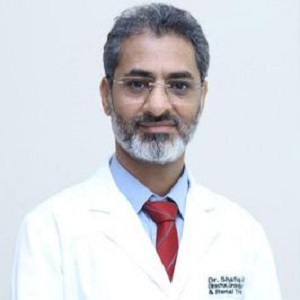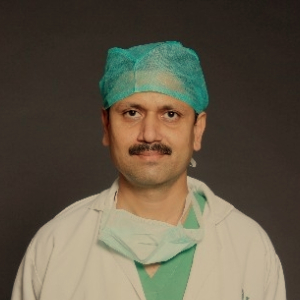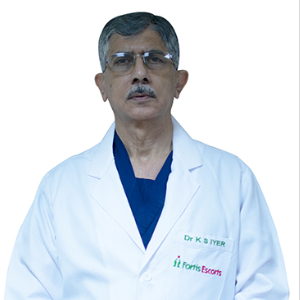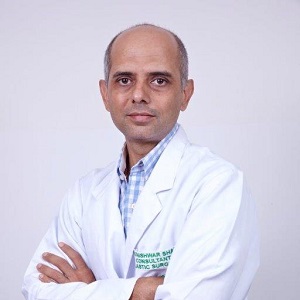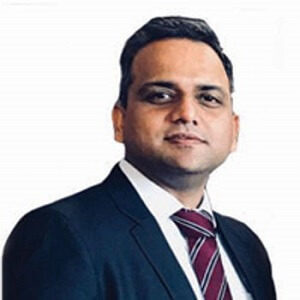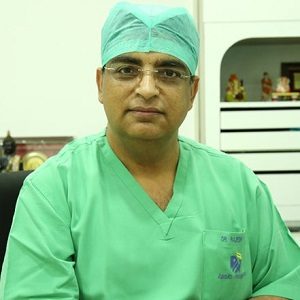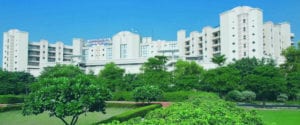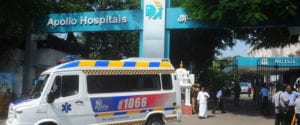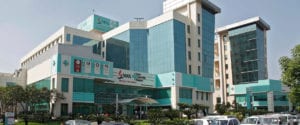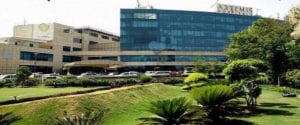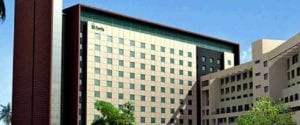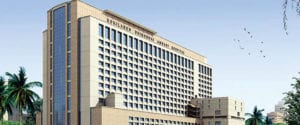Best Doctors in India for AVM Brain Treatment
- Director – Urology, Andrology & Renal Transplants
- 16+ years
Profile Highlights:
Profile Snapshot of Dr. Shafiq Ahmed
- With over 16 years of experience, Dr. Shafiq Ahmed is a highly skilled urologist and robotic surgeon.
- He has previously worked at some of the best hospitals in India and was instrumental in establishing Renal Transplant Programmes in some of the top hospitals within Delhi-NCR.
- Dr. Ahmed also holds US credentials as a robotic uro-oncologist.
- He has authored numerous book chapters and articles in medical journals on urological diseases.
- As one of the leading urologists, robotic surgeons, and renal transplant surgeons, Dr. Ahmed has trained many upcoming doctors in his field.
- He has also been a prominent speaker at various medical conferences.
- Surgical Oncologist, New Delhi, India
- Over 20 years’ experience
Profile Highlights:
- Dr. S M Shuaib Zaidi is a Senior Consultant of Surgical Oncology at Apollo Cancer Institute of Indraprastha Apollo Hospital.
- His expertise lies in the surgical treatment of cancer of the lungs, esophagus, breast, GI tract, and mediastinal regions.
- Dr. Shuaib Zaidi has close to 2 decades of experience in the field of Surgical Oncology and his expertise lies in Thoracic Oncology surgery.
- Dr. Shuaib is known to have developed an innovative technique known as Radical Neck dissection for head and neck cancer surgery that helps in preserving the marginal mandibular nerve in order to ease the cosmetic outcome of the procedure.
- Dr. Zaidi also has experience in Robotic Surgery and received training in the procedure from IRCAD in Strass Bourg, France.
- Pediatric Cardiac Surgeon, New Delhi, India
- Over 40 years’ experience
Profile Highlights:
- Dr. Krishna Subramony Iyer is one of the best Pediatric Cardiac surgeons in India and specializes in congenital heart diseases.
- He has been practicing pediatric cardiac surgery for over 4 decades and has performed more than 10,000 surgeries through various procedures like double switch operation TAPVC repairs, Fontan and Fontan, arterial switch, and DORV.
- Dr. Iyer has been associated with Escorts Heart Institute for a long time and is responsible for establishing the first pediatric cardiac care program in North India in 1995.
- Plastic & Cosmetic Surgeon, Gurugram, India
- Over 20 years’ experience
Profile Highlights:
- Dr. Adhishwar Sharma is a reputed plastic surgeon, with an extensive experience in plastic and reconstructive surgery.
- He has been associated with various hospitals like Fortis hospital Noida, Batra Hospital, Metro hospital Faridabad, and Central hospital Faridabad.
- He has an interest in Brachial Plexus reconstruction and lymphedema. He has published articles in various international and national journals. He is a member of various professional bodies.
- Endocrinologist, Diabetologist, New Delhi, India
- Over 26 years’ experience
Profile Highlights:
- Dr. Mohammada Asim Siddiqui is one of the best endocrinologists in India. He has an experience of over 26 years in the field. Dr. Siddiqui is active as a senior consultant – endocrinologist with Apollo Centre for Obesity, Diabetes, & Endocrinology, New Delhi.
- Dr. Siddiqui specializes in Internal Medicine & manages Diabetes, Endocrine and Metabolic Disorders, skin allergies, and Piles Treatment.
- His interest in Diabetes mainly focuses on young and gestational diabetes & Post-transplant & post-metabolic surgery diabetes.
- Dr. Siddiqui is also involved in various clinical research and has penned more than 50 articles in national and international journals.
- Robotic Urologist, New Delhi, India
- Over 27 years’ experience
Profile Highlights:
- Dr. Rajesh Taneja is one of the best Urologists in India, having experience of more than 27 years in the specialization. He is practicing at Apollo Hospitals, New Delhi as a senior consultant.
- Dr. Taneja specializes in surgeries to correct Congenital anomalies of urinary organs; Phimosis, PUJ Obstruction, Megaureter, Hydronephrosis, Vesicoureteric reflux (VUR), Hypospadias, Posterior Urethral Valves (PUV), Ectopia vesicae, and others.
- He is formally trained in the Robotic Surgical system and is one of the few urologists performing Robotic urological surgeries in India.
- Dr. Taneja has expertise in the Holmium Laser Enucleation of prostate technique.
- He has written numerous papers in national and international scientific publications.
- Dr. Rajesh Taneja also authored a book titled ‘Interstitial Cystitis’.
Best Hospitals in India for AVM Brain Treatment
Indraprastha Apollo Hospital, New Delhi
- City: New Delhi, India
Hospital Highlights:
- Indraprastha Apollo Hospital is a 700-bedded multispecialty hospital in the heart of the capital of India. It is a part of Apollo Hospital group, one of India’s most reputed healthcare chains. Indraprastha Apollo Hospital has been accredited by Joint Commission International, making it the first internationally accredited hospital in the country in 2005.
- There are 52 specialties in the hospital with one of the best cardiology centers in the country. The hospital is also equipped with State of the art infrastructure facilities with the largest Sleep Lab in Asia and the largest number of ICU bed facilities in India.
- The hospital also has one of the largest dialysis units in India along with a dedicated Bone Marrow Transplant unit.
- The latest and highly advanced technologies that are installed in the hospital include Da Vinci Robotic Surgery System, PET-MR, PET-CT, Cobalt-based HDR Brachytherapy, Brain Lab Navigation System, Tilting MRI, Portable CT scanner, 3 Tesla MRI, 128 Slice CT scanner, DSA Lab, Endosonography, Hyperbaric Chamber and Fibro scan.
Fortis Memorial Research Institute, Gurugram
- City: Gurugram, India
Hospital Highlights:
- Fortis Memorial Research Institute is a multi-super-specialty, quaternary care hospital with 1000 beds. The hospital comprises reputed clinicians, and international faculty and is also equipped with cutting-edge technology. The hospital is a part of Fortis Healthcare Limited, a reputed chain of private hospitals in India.
- It is a NABH-accredited hospital that is spread across 11 acres of land and has a capacity of 1000 beds. The hospital has 55 specialties and is one of the premier health care centers in the Asia Pacific region popularly known as “the Mecca of Healthcare”.
- The hospital has 260 diagnostic centers and is also equipped with the latest and advanced techniques that include 3 Telsa which is the world’s first Digital MRI technology. The hospital also has world-class Radiation Therapy techniques which have been developed by leading technology experts from Elekta and Brain Lab.
Apollo Hospital, Chennai
- City: Chennai, India
Hospital Highlights:
- Apollo Hospitals, Chennai, is one of the best hospitals for heart care in India. Over the years, Apollo has expanded all over India, as a healthcare chain.
- India’s first ‘Only Pancreas’ transplant was performed in Apollo Hospital. The hospital is known for successfully performing Asia’s first en-bloc combined heart and liver transplant, and over the years, it has attained a remarkable achievement in the global healthcare space. Around 3-4 organ transplants are performed in the hospital per day.
- Equipped with over 500 beds, this hospital in Chennai was established in 1983 and since then has been among the most preferred hospital for patients from all over the world.
- The hospital holds accreditation of the NABH and JCI and is the first hospital in India to be ISO 9001 and ISO 14001 certified. It is also the first South Indian Hospital to receive subsequent reaccreditation from the JCI USA 4 times.
Medanta-The Medicity, Gurgaon
- City: Gurugram, India
Hospital Highlights:
- One of India’s best and largest multi-specialty hospitals, Medanta was built with the aim to bring India to the highest standards of medical care. The hospital has been providing the best medical services to its patients, since its inception, with care, commitment, and compassion.
- Equipped with 1250 beds, the hospital was founded by Dr. Naresh Trehan in the year 2009 with an aim to provide the best medical care at affordable costs. The hospital is spread across 43 acres and includes 45 operation theatres and 350 beds dedicated solely to ICU. The hospital includes over 800 doctors, and more than 22 specialty departments and has a dedicated floor for individual specialty in order to offer the best services under one roof.
- The hospital is considered one of the premier institutes in India for Cardiac Care and includes staffs and members of high caliber. The hospital has 6 distinct centers of excellence.
Max Super Specialty Hospital, New Delhi
- City: New Delhi, India
Hospital Highlights:
- One of the well-regarded providers in India committed to the highest standards of clinical excellence and patient care, Max Super Specialty Hospital is a part of Max Healthcare, which is the second-largest healthcare chain in India. Regarded as one of the most well-regarded healthcare providers in the country, Max Super Specialty Hospital is committed to the highest standards of clinical excellence as well as patient care. The hospital is also equipped with the latest technology as well as cutting-edge research. The hospital is known to deliver and ensure the highest level of patient care.
- The hospital has more than 500 beds and offers treatment for over 35 specialties. The hospital also holds the credit of having installed the first Brain Suite in Asia. This is a highly advanced Neurosurgical machine that allows MRI to be taken while surgery is ongoing.
- Other advanced and latest technologies are also installed in the hospital such as the 1.5 Tesla MRI machine, 64 Slice CT Angiography, 4D ECHO, LINAC, and 3.5T MRI machine.
Artemis Hospital, Gurugram
- City: Gurugram, India
Hospital Highlights:
- One of the most well-known hospitals in the Delhi NCR, Artemis Hospital is the first hospital in Gurugram to get accredited by the Joint Commission International.
- With more than 40 specialties, the hospital has been designed to be one of the most technically advanced hospitals in the country, with the best medical and surgical health care. The hospital has eleven special and dedicated centers, for Heart, Cancer, Neurosciences, etc.
- The latest technologies in the hospital include Endovascular Hybrid Operating Suite and Flat panel Cath Labs for the cardiovascular department, 3 Tesla MRI, 16 slice PET CT, 64 Slice Cardiac CT Scan, HDR Brachytherapy, and highly advanced Image Guided Radiation Therapy techniques (LINAC) are installed in the hospital.
- The hospital has won several awards as well, since its inception.
BLK Max Super Specialty Hospital, New Delhi
- City: New Delhi, India
Hospital Highlights:
- Equipped with 650 beds, BLK Superspecialty Hospital is the largest stand-alone private sector hospital in Delhi.
- With over 1500 healthcare providers and 150 globally renowned super specialists, the hospital is one of Asia’s largest Bone Marrow Transplant Centres. The hospital is known for having some of the best cancer doctors in the country.
- The hospital is NABH and NABL accredited and was inaugurated by the first Prime Minister of India. Pt. Jawahar Lal Nehru.
Gleneagles Global Hospitals, Chennai
- City: Chennai, India
Hospital Highlights:
- Established in 1999, Gleneagles Global Hospital, Chennai, is one of the top healthcare facilities in Southern India. It is part of the Gleneagles Hospital Chain, which is the fourth largest healthcare chain in the country. The hospital specializes in multi-organ transplants of kidneys, liver, lungs, heart, etc.
- The hospital has an excellent infrastructure and state-of-the-art lab and equipment set-up. The hospital boasts cutting-edge technologies, a highly skilled team of doctors and surgeons, and trained support staff. Located in Perumbakam, Chennai, it is one of India’s premier health care destinations. The hospital has performed some of the most complex surgical and clinical procedures in India including multi-organ transplantations.
- The hospital’s lung transplantation program is one of the best in the country. The hospital is known for having performed India’s first single lung transplant and first minimal invasive lung transplant. It is also the only Indian hospital to be associated with King’s College Hospital, London, United Kingdom for liver transplantations.
Fortis Hospital, Mulund, Mumbai
- City: Mumbai, India
Hospital Highlights:
- Fortis Hospital in Mulund is a 315-bed multi-speciality tertiary care hospital with five JCI accreditations that offers a wide variety of diagnostic and therapeutic services. The Fortis Hospital in Mulund delivers patient-centred treatment with cutting-edge technology, highly skilled and experienced surgeons, and paramedical staff.
- This institution houses Maharashtra’s largest multi-organ transplant centre. It is also the first heart transplant centre in western India to conduct 100 or more consecutive heart transplants in under four years. It is the only hospital in the city to have multi-organ transplants and has handled the youngest patient for angioplasty. Fortis Hospital Mulund now boasts the first advanced surgical robot in central Mumbai.
- Cardiology and heart surgery, urology, nephrology, neurosciences, orthopaedics, digestive care, emergency and critical care, and maternity care are among the services provided by the hospital.
Kokilaben Dhirubhai Ambani Hospital, Mumbai
- City: Mumbai, India
Hospital Highlights:
- Kokilaben Dhirubhai Ambani Hospital, Named after the wife of Indian industrialist Dhirubhai Ambani, the founder of Reliance Industries, this is one of the top hospitals in Mumbai. This 750-bed multi-specialty hospital became operational in 2009. Known as one of India’s most advanced tertiary care facilities, the hospital is designed to raise India’s global standing as a healthcare hub, with an emphasis on excellence in clinical services.
- Kokilaben Dhirubhai Ambani Hospital uses Protocol and Care Pathway based treatment models to ensure the best outcomes for patients.
- The hospital represents a confluence of top-notch talent, cutting-edge technology, state-of-the-art infrastructure, and, most importantly commitment.
- The hospital also holds the accreditation of the NABH, NABL, CAP, and JCI.
- The hospital has been recognized as the No. 1 Multispecialty Hospital in Mumbai and the West Zone for the fifth year in a row in 2020 by The Week.
WHAT IS AN AVM BRAIN?
What causes Brain AVM?
The primary cause of AVM is still unclear. Some people have brain AVM by birth while some others develop the same later. A notable point is the passing down of this malformation amongst families, genetically.
Occurrence rate of AVMs
Brain AVMs occur very rarely and their occurrence rate is around 1% of the population. However, you might observe male predilection for AVM of the brain.
Where AVMs occur
Although an AVM may develop anywhere within the body, the most common sites are the brain and spine. However, brain AVM is rare and affects only a small chunk of the human population.
Symptoms of Brain AVMs
You may not notice any symptoms of brain AVM till it ruptures. Rupturing of AVM of the brain may result in bleeding within the brain which is termed hemorrhage. A majority of the patients with brain AVM experience hemorrhage as the first sign. Other symptoms of brain AVM include:
- Constant pain in any specific area of the head
- Problems with speech
- Progressive loss of neurological function
- Numbness or paralysis
- Dizziness
- A problem in understanding language
- Nausea and vomiting
- A problem in performing certain tasks that require planning
- Back pain
- Loss of coordination
- Seizures
- Muscle weakness in a specific part of the body
- Loss of consciousness
- Weak lower limbs
- Confusion
- Vision loss
- Serious unsteadiness
- Hallucinations
- Inability to understand what others are saying
- Loss of control on eye movements
- Tingling sensations
Causes of bleeding AVM
The abnormal blood vessels in brain AVM are weak. Hence, they direct blood in a direction against the tissues of the brain. As there is dilation of the abnormal blood vessels with time, they tend to burst. A brain AVM ruptures and bleeds because of the blood flow in a high pressure coming from the arteries.
Chances of AVM bleeding
A brain AVM generally develops between the age of 10 years to 40 years. On average, the chances of bleeding of brain AVM is between 1% to 3% per year. If it bleeds for the first time, the patients are at risk of recurrent bleeding within a short period. Teenagers and the young age group people are at a high risk of experiencing recurrent bleeding.
When to visit the doctor?
If you notice any signs or symptoms of brain AVM, you must visit the doctor immediately. These cases require emergency medical attention otherwise they may bleed profusely & prove to be fatal.
Stages of brain AVM
- Stage 1 of Quiescence: AVM brain malformation is quiet in this stage. The skin surface above the AVM is red and feels a little warm.
- Stage 2 of Expansion: The malformation increases in size to become larger and it is easy to feel the pulse within the malformation.
- Stage 3 of Destruction: The brain AVM begins to bleed and pain.
- Stage 4 of Decompensation: This stage may turn out to be fatal as heart failure occurs in most cases.
Can AVM bleeding prove fatal?
Around 10% to 15% of deaths occur after each AVM brain bleeding. Some patients experience permanent brain damage that accounts for around 30% of the total cases. Every bleed contributes to the damage of normal tissues within the brain that may alter the normal brain functions temporarily or permanently.
Types of Brain AVM
There are 5 different types of brain AVM. These types are listed as under:
- True AVM: This is the most common type of malformation in which the abnormal blood vessels tangle. However, there is no interfering normal tissue of the brain.
- Venous malformation: This malformation involves only the abnormal veins.
- Dural fistula: Dura mater, the covering of the brain, often gets involved in an abnormal connection with the blood vessels. This results in the formation of a dural fistula. There are three types of dural fistulas namely transverse- sigmoid sinus dural fistula, dural carotid-cavernous sinus fistula, and sagittal sinus-scalp dural fistula.
- Cryptic or occult AVM or cavernous malformations: This type of vascular brain malformation doesn’t draw away large quantities of blood. Such malformations may cause seizures and bleed.
- Hemangioma: Abnormal blood vessels at the brain or skin surface are termed hemangioma.
Risk factors of Brain AVM
Males are at a higher risk of developing brain AVM. Apart from this, families with a history of brain AVM have generic passing down of the same.
Complications of Brain AVM
The complications of brain AVM include stroke, speech or movement problems, low quality of life, developmental delays (in children), and numbness in specific parts of the body. Other complications associated may be:
- Weaker blood vessels: An AVM brain exerts pressure on the weaker blood vessels. This may result in an aneurysm or a bulge in the walls of the blood vessels that may rupture later.
- Hemorrhage: AVM causes the walls of the affected veins and arteries to weaken which results in bleeding within the brain or hemorrhage. While hemorrhage goes undetected in some people, some others experience episodes that may be life-threatening.
- Brain damage: In many cases, AVM increases in size to constrict some portions of the brain. Because of this, protective fluids are unable to circulate freely and instead collect at a place. This may cause brain tissue to get pushed against the skull resulting in brain damage.
- Reduced oxygen supply: When brain AVM develops, blood circulates directly to the veins & the arteries. Because of this, surrounding tissues are unable to absorb oxygen from the blood, and these tissues weaken or die.
How Brain AVMs are diagnosed
Your doctor will review all your symptoms and perform a thorough examination. For forming a diagnosis, he or she might ask you to undergo certain tests. These tests are usually performed by neuroradiologists. They are professionally trained to conduct imaging tests for finding the cause and the diagnosis of the condition.
Tests
- CT scan: A Computerized Tomography scan creates a cross-sectional radiographic image of the brain through an x-ray series. Sometimes, doctors perform angiograms which involves injecting a dye. This dye is injected into the veins through a tube so that minute details can be seen.
- Cerebral arteriography: Also called cerebral angiography, it helps to accurately diagnose AVM. It reveals not only the characteristics of arteries that supply AVM and the draining veins but also the exact location. These details are essential for the diagnosis and treatment of the condition. Your doctor will insert a tube called a catheter in the artery of the groin region. He or she will use x-ray imaging to thread it to the brain. Injecting the dye will make the blood vessels clear enough to be seen in the x-ray imaging.
- MRI: Magnetic Resonance Imaging uses radio waves and magnets to obtain precise brain images. This test will provide you with the exact location of AVM within the brain along with any other bleeding spot. Alternatively, your doctor might perform Magnetic Resonance Angiogram using the dye.
Treatment of Aterivenous Malformations (AVMs) of Brain
There are ample treatment options for this malformation. The primary goal is to avoid hemorrhage but it is vital to consider the neurological complications. Your health, gender, age, location, and size of the blood vessels are some critical factors that help in determining the right treatment option.
Stereotactic radiosurgery
This type of treatment involves radiation for the destruction of the brain AVM. To simply put, this isn’t surgery but involves targeting of AVM by the radiation beams. This damages the abnormal blood vessels leaving a scar. The scarred blood vessels clot off within a few years of the treatment. If you have a small AVM that can’t be removed with conventional surgery then your doctor might suggest SRS. People having hemorrhages that may turn fatal also undergo SRS treatment
Endovascular Embolization
It is also called interventional neuroradiology. Your doctor will insert a catheter tube into the artery of your leg and thread it with the brain blood vessels. The catheter is placed in one of the arteries that feed AVM followed by injecting of the embolizing agent. This will block the blood flow to the feeding artery. This is a minimally invasive procedure and is usually done before any surgery. It reduces the chances of AVM bleeding and reduces its size. Endovascular embolization also decreases the chances of stroke-type symptoms.
Surgical removal or resection
If the AVM is bleeding or is located in an easily accessible area of the brain, resection via conventional brain surgery is a preferable treatment option. Your doctor will temporarily remove a portion of your skull to perform resection. AVM can be easily removed with the help of special clips followed by reattachment of the skull bone. Suturing of the incision follows this process to close the scalp region.
Medical therapy
If you aren’t experiencing any symptoms of AVM or the AVM is located in an inaccessible area, you will undergo conservative management. Your doctor will ask you to avoid excess workouts and exercise. Also, you will have to discontinue the intake of blood thinners or anticoagulants like warfarin.
Specialists for brain AVM treatment
A brain AVM treatment is performed by specialists who hold a specialization degree in such cases. They may be:
- A neurosurgeon or radiation therapist who performs stereotactic radiosurgery treatment.
- A stroke neurologist who is proficient in the medical management of such malformations. They can also diagnose easily and perform imaging of the head, neck, and brain region.
- The vascular neurosurgeon can perform surgical removal of AVM of the brain.
- An endovascular neurosurgeon or interventional neuroradiologist who excels in endovascular therapy.
Prevention and prognosis
Most commonly, an AVM occurs by birth or sometime later after the birth of the child. Prevention is difficult as the causes are unknown for a majority of the cases. However, the best thing would be to seek medical attention as soon as you notice the first symptom for a better prognosis. Timely medical treatment always helps in easy management and provides a better quality of life. People who get to know about AVM through bleeding usually die. Some others experience seizures and problems with the nervous system. Many people with undetected AVM till their 50s or 60s experience no symptoms and are stable.
Follow up
You need to visit your doctor regularly for follow-ups after getting surgically operated on for brain AVM. Your doctor might advise you imaging tests again to ensure there is no recurrence and the malformation has resolved completely.
FAQs on Brain AVM
Brain AVM is curable within 2-3 years of treatment. Radiosurgery is often a treatment choice for AVMs that are small in size but in exceptional cases, one may opt for it even for the removal of large AVMs.
One in 2000 people develop brain AVM. A majority of the people live normally with it but they have a risk of bleeding AVM at some time. Sometimes, they may also suffer a stroke due to AVM.
In most cases, AVMs do not rupture. However, there may be recurrent bleeding after it ruptures once.
Most of the asymptomatic AVM cases have a history of bleeding. Due to increased stress, you may have high BP. This may cause the AVM to bleed as the blood will flow at a fast rate and the vessel walls will be weak.
The most important thing to keep in mind is that you must avoid anything that elevates the blood pressure. If you perform a high workout or a strenuous activity, your blood pressure may rise. This will result in strain on your malformation and there are high chances of AVM rupture or bleeding.
AVM is a collection of abnormal blood vessels that restrict blood circulation to the brain. It may sometimes be accompanied by vascular tumors that are surgically removed.
Although there are no cases of passing down of AVM in families, a mere 5% of cases are due to autosomal dominance. However, the causes of AVM are still unknown in a majority of the cases as it is present by birth.
A Grade 4 or Grade 5 AVM is considered a large AVM as it is big and deep within the brain. In most cases, a large AVM is considered to be a risky malformation to be operated upon.
No, AVM hasn’t been identified as a condition of disability but severe complications of its rupture may result in the disability of the person.
No, a brain AVM does not cause any kind of personality changes. However, a patient may experience emotional changes due to the stress of the same.
The warning signs of a brain aneurysm are seizures, headache, nausea, vomiting, loss of consciousness, stiff neck, drooping eyelids, and blur vision.
The symptoms of a brain aneurysm headache are pulsing sensation and throbbing pain. This may last for a couple of hours to a few days and it may be debilitating. The patient might also experience sensitivity to extreme sound and sunlight.
Medical therapy can help you get relief from the symptoms of AVM like headache and pain. You can perform routine activities only after several weeks following the surgery. Most patients require around 4 to 6 months to completely recover from the condition.
There will be a headache suddenly that is severe enough to disturb the patient. The patient will experience headaches in only a specific region of the head with a ringing sound in the ear.
A Cavernoma or a cavernous angioma or a cavernous malformation is one of the types of AVM of the brain. It also contains a collection of weakened blood vessels that block the blood flow.

